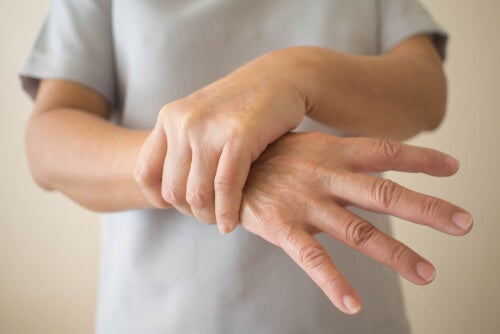Extrapyramidal Symptoms: What Are They?

Extrapyramidal symptoms are all motor problems produced most often as a result of antipsychotic medications. It’s essentially an illness of the motor functions that happens because of damage to the extrapyramidal system. That system is basically the brain’s basal ganglia and the gray matter and pathways in them.
The extrapyramidal system deals with your control over voluntary movements and muscles. It also deals with automatic, instinctive, and learned movements. This is why whenever there’s an issue with the system, you may start to experience problems with movement, stretching, and posture.
The clearest example of extrapyramidal symptoms at work is Parkinson’s disease. In fact, all the symptoms that define an extrapyramidal issue are symptoms of Parkinson’s too.

What causes extrapyramidal symptoms?
Extrapyramidal symptoms generally happen as a negative reaction to antipsychotic medication. But there are also cases where they can happen because of damage to certain areas of the brain. The basic cause is a lack of dopamine regulation. Dopamine is the main neurotransmitter involved in human motor function.
Antipsychotic, or neuroleptic medications block D2 dopamine receptors. They do this to keep the dopamine pathways from lighting up in the brains of patients with psychosis. But blocking those pathways can cause some changes to motor function, or what we call “extrapyramidal symptoms.”
Typical antipsychotic medications tend to cause the most problems with extrapyramidal symptoms. In fact, atypical medications actually came about to get around these common side effects. The medications most likely to cause these symptoms are haloperidol and chlorpromazine.
The main extrapyramidal symptoms
Here are some of the main symptoms people experience:
- Hypokinesia: a reduction in the speed and ability to perform voluntary movements. These kinds of movements start to take a lot of effort, and become slow and clumsy.
- Hypertonia: an increase in muscle tension. It’s especially bad in the extremities. Some people also experience acute dystonia in the muscles in their face, neck, and tongue.
- Akathisia: this symptom is basically a sense of restlessness and agitation. You can’t sit still.
There are also lots of other motor symptoms associated with problems of this nature. That includes things such as:
- Hyperkinesia: involuntary movements like tics, spasms, and twitching.
- Involuntary, rhythmic, back and forth shaking. These can happen while lying down, or while maintaining a specific posture for a long time.
- Parkinson’s movements. This involves having your head and neck bent forward, and your elbows, knees, and wrists bent too.
- Amimia: the inability to make facial expressions. This happens because of stiff muscles in the face.
- Abnormal gait: this usually shows up in the form of short steps where your arms don’t move back and forth. People with this issue have trouble keeping their balance.
- Trouble writing and speaking.
- A lack of both postural reflexes and the ability to make quick, automatic movements.

Treating the symptoms
For the most part, when for some reason the treatment needs to happen fast, they’ll use anticholinergic and dopaminergic drugs. But in most cases, the basic treatment for extrapyramidal symptoms is to take the patient off of the medication that caused them.
If they’re undergoing treatment with typical antipsychotics, a doctor will generally try to put them on a new medication with fewer side effects, like typical antipsychotics.
But as far as preventing extrapyramidal symptoms from antipsychotic medications before they begin, the main thing to do is keep close control of the dosages. You also need to be on the lookout for any possible negative reactions and react quickly to avoid further problems.
When it comes to treating facial tension and motor function alterations, physiotherapy can be a big help. That’s even truer when it comes to cases of brain damage or damage to extrapyramidal pathways. Physiotherapy can be a huge help when it comes to rehabilitating people. It has concrete benefits for their quality of life.
Extrapyramidal symptoms are all motor problems produced most often as a result of antipsychotic medications. It’s essentially an illness of the motor functions that happens because of damage to the extrapyramidal system. That system is basically the brain’s basal ganglia and the gray matter and pathways in them.
The extrapyramidal system deals with your control over voluntary movements and muscles. It also deals with automatic, instinctive, and learned movements. This is why whenever there’s an issue with the system, you may start to experience problems with movement, stretching, and posture.
The clearest example of extrapyramidal symptoms at work is Parkinson’s disease. In fact, all the symptoms that define an extrapyramidal issue are symptoms of Parkinson’s too.

What causes extrapyramidal symptoms?
Extrapyramidal symptoms generally happen as a negative reaction to antipsychotic medication. But there are also cases where they can happen because of damage to certain areas of the brain. The basic cause is a lack of dopamine regulation. Dopamine is the main neurotransmitter involved in human motor function.
Antipsychotic, or neuroleptic medications block D2 dopamine receptors. They do this to keep the dopamine pathways from lighting up in the brains of patients with psychosis. But blocking those pathways can cause some changes to motor function, or what we call “extrapyramidal symptoms.”
Typical antipsychotic medications tend to cause the most problems with extrapyramidal symptoms. In fact, atypical medications actually came about to get around these common side effects. The medications most likely to cause these symptoms are haloperidol and chlorpromazine.
The main extrapyramidal symptoms
Here are some of the main symptoms people experience:
- Hypokinesia: a reduction in the speed and ability to perform voluntary movements. These kinds of movements start to take a lot of effort, and become slow and clumsy.
- Hypertonia: an increase in muscle tension. It’s especially bad in the extremities. Some people also experience acute dystonia in the muscles in their face, neck, and tongue.
- Akathisia: this symptom is basically a sense of restlessness and agitation. You can’t sit still.
There are also lots of other motor symptoms associated with problems of this nature. That includes things such as:
- Hyperkinesia: involuntary movements like tics, spasms, and twitching.
- Involuntary, rhythmic, back and forth shaking. These can happen while lying down, or while maintaining a specific posture for a long time.
- Parkinson’s movements. This involves having your head and neck bent forward, and your elbows, knees, and wrists bent too.
- Amimia: the inability to make facial expressions. This happens because of stiff muscles in the face.
- Abnormal gait: this usually shows up in the form of short steps where your arms don’t move back and forth. People with this issue have trouble keeping their balance.
- Trouble writing and speaking.
- A lack of both postural reflexes and the ability to make quick, automatic movements.

Treating the symptoms
For the most part, when for some reason the treatment needs to happen fast, they’ll use anticholinergic and dopaminergic drugs. But in most cases, the basic treatment for extrapyramidal symptoms is to take the patient off of the medication that caused them.
If they’re undergoing treatment with typical antipsychotics, a doctor will generally try to put them on a new medication with fewer side effects, like typical antipsychotics.
But as far as preventing extrapyramidal symptoms from antipsychotic medications before they begin, the main thing to do is keep close control of the dosages. You also need to be on the lookout for any possible negative reactions and react quickly to avoid further problems.
When it comes to treating facial tension and motor function alterations, physiotherapy can be a big help. That’s even truer when it comes to cases of brain damage or damage to extrapyramidal pathways. Physiotherapy can be a huge help when it comes to rehabilitating people. It has concrete benefits for their quality of life.
All cited sources were thoroughly reviewed by our team to ensure their quality, reliability, currency, and validity. The bibliography of this article was considered reliable and of academic or scientific accuracy.
- Hernández, O. M., Fajardo, X. R., Fernández, E. A., Rodríguez, O. L. M., & Urra, F. M. (2006). Síndrome extrapiramidal inducido por neurolépticos. Revista Médica Electrónica, 28(3), 185-193.
- Cicero, A. F., Forghieri, M., Cuzzola, D. F., Cipressi, F. E. D. E. R. I. C. A., & Arletti, R. (2002). Extrapiramidal syndrom, anticholinergic effects and orthostatic hypotension induced by antipsycotic drugs under everyday practice conditions in Italy: the PPHSS study. Rivista di psichiatria, 37(4), 184-189.
- Ortega-Soto, H. A., Jasso, A., Ceceña, G., & Ávila, C. A. H. (1991). La validez y la reproducibilidad de dos escalas para evaluar los síntomas extrapiramidales inducidos por neurolépticos. Salud Mental, 14(3), 1-5.
This text is provided for informational purposes only and does not replace consultation with a professional. If in doubt, consult your specialist.







